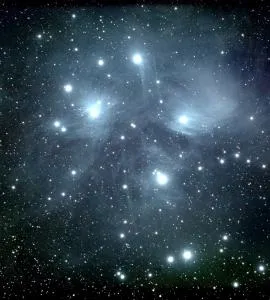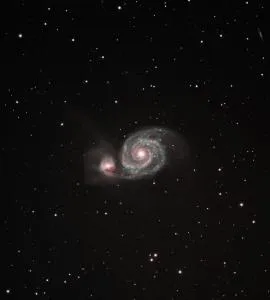NGC 6888 Crescent Nebula captured with Takahashi FSQ-106EDEX4

Discover the stunning NGC 6888 Crescent Nebula captured with the Takahashi FSQ-106EDEX4 by Richard Harris. This remarkable image showcases the intricate details and vibrant colors of this celestial wonder, making it a must-see for astrophotography enthusiasts and stargazers alike.
Welcome to another mesmerizing journey through the cosmos. Today, I'm thrilled to present an extraordinary capture of the NGC 6888 Crescent Nebula, a celestial marvel nestled in the constellation Cygnus. This awe-inspiring image was taken using my Takahashi FSQ-106EDEX4 telescope, coupled with the ZWO 2600MM camera. Over the course of three clear nights, I shot over 15 hours of total acquisition time to bring out the intricate details and vibrant hues of this nebula.
The Crescent Nebula, also known as NGC 6888, is an emission nebula formed by the powerful stellar winds from its central star, WR 136. This Wolf-Rayet star is nearing the end of its life, shedding its outer layers and creating the beautifully complex and bright structure we see today. The interplay of glowing gases and dust creates a vivid tapestry of reds and blues, making it a favorite target for astrophotographers like myself.
The Takahashi FSQ-106EDEX4 is renowned for its exceptional optics and wide-field capabilities, making it ideal for capturing expansive deep-sky objects. Paired with the ZWO 2600MM camera, known for its high sensitivity and low noise, the setup allowed for an incredibly detailed and dynamic representation of this celestial phenomenon.
Throughout the 15 hours of data collection, I employed a combination of narrowband filters to isolate the specific wavelengths of light emitted by the nebula’s ionized gases. This technique not only enhances the contrast and detail of the nebula but also minimizes the interference of light pollution and atmospheric disturbances.


Five interesting facts about NGC 6888 The Crescent Nebula
Formation by a Wolf-Rayet Star: The Crescent Nebula was formed by the powerful stellar winds from its central star, WR 136, a Wolf-Rayet star. These stars are massive, evolved stars known for their strong stellar winds that eject material at high speeds, shaping the surrounding nebula.
Two Distinct Shells: The Crescent Nebula consists of two distinct shells. The inner shell was created by the slow stellar wind from WR 136 during its red supergiant phase, while the outer shell was formed by the faster stellar wind from the Wolf-Rayet phase. The interaction between these two winds creates the nebula's intricate structure.
Ionized Gas Emission: The nebula's striking appearance is due to the ionization of hydrogen, oxygen, and sulfur gases by the intense ultraviolet radiation from WR 136. This ionization causes the gases to emit light at specific wavelengths, resulting in the nebula's characteristic red and blue colors.
Distance and Size: The Crescent Nebula is located about 4,700 light-years away from Earth in the constellation Cygnus. It spans approximately 25 light-years across, making it a relatively large nebula that can be observed with amateur telescopes under dark skies.
Discovery and Naming: The Crescent Nebula was discovered by the British astronomer Friedrich Wilhelm Herschel in 1792. It is sometimes referred to as the "Crescent Nebula" due to its distinctive crescent-like shape, which is easily recognizable in astrophotographs and through telescopes.

NGC 6888 Crescent Nebula acquisition details
Date: May 27th - May 30th, 2024
Direction of Observation: North East 67 degrees, Alt = + 11 degrees
Telescope: Takahashi FSQ-106EDEX4 at 530mm, F5
Mount: ZWO AM5
Camera: ZWO 2600MM, Temp= -20, Gain= 100 / ZWO filters
Guide Scope: Williams Optics 50mm
Guider: ZWO ASI 120 mini
Controller: ZWO ASI Air
Acquisition:
Sulfur II: 18 frames at 300s each = 1.5 hours
Hydrogen Alpha: 88 frames at 300s each = 7.3 hours
Oxygen III: 50 frames at 300s each = 4.15 hours
Red: 10 frames at 180s each = .5 hours
Blue: 10 frames at 180s each = .5 hours
Green: 10 frames at 180s each = .5 hours
Total acquisition time = 15 hours
Darks/Flats/Bias: (None)
Luminance: (None)
Processing: Pixinsight, Photoshop
Location: Missouri
Bortle Class Sky: 4

Isaiah 40:26 - "Lift up your eyes and look to the heavens: Who created all these? He who brings out the starry host one by one and calls forth each of them by name. Because of his great power and mighty strength, not one of them is missing."
About the Author

Meet Richard Harris, a passionate and dedicated astronomer who embarked on a cosmic journey at the age of 11 and has been reaching for the stars ever since. Born with an innate curiosity for the universe. Richard's fascination with astronomy ignited when he first gazed up at the night sky and felt an indescribable connection to the cosmos and creation. As a younger lad, Richard spent countless hours poring over astronomy books, studying constellations, and learning about the celestial wonders that grace our skies. In 2001, Richard invented the HyperTune telescope process, which has grown into the standard for German equatorial telescope mount tuning across the globe. He is also the founder of ScopeTrader, a global resource helping to grow the hobby of astronomy which started in 2002, and the CEO of Moonbeam software company, started in 2008. When he's not taking photos of our universe, you can find him with family, playing guitar, or traveling.











